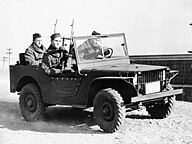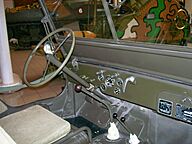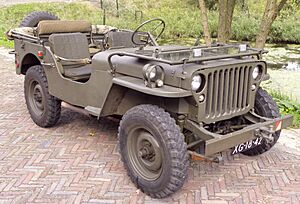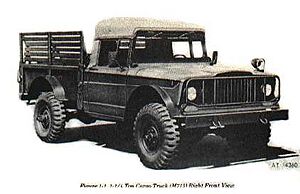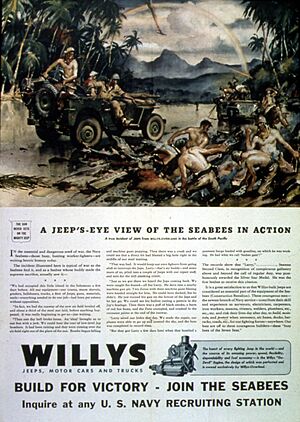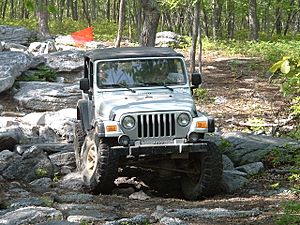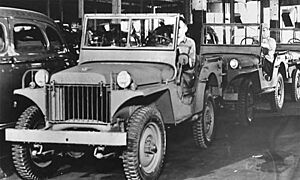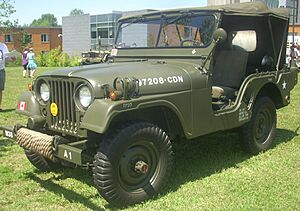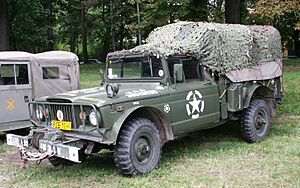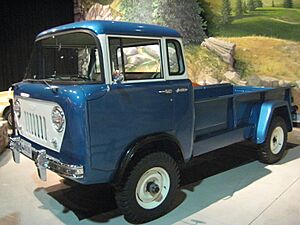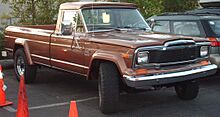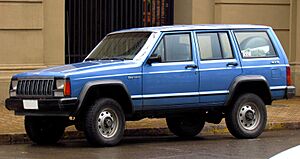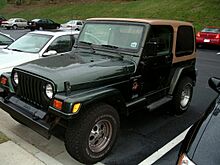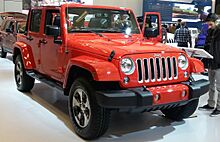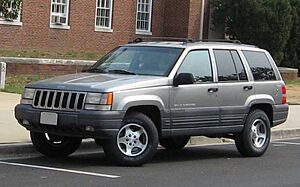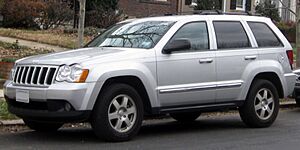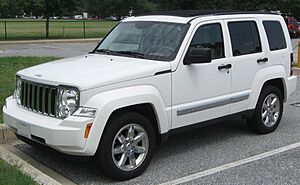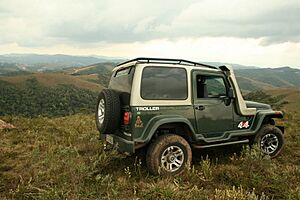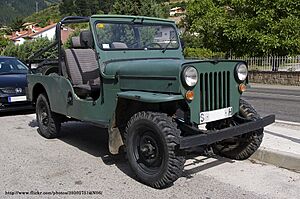Jeep facts for kids
 |
|
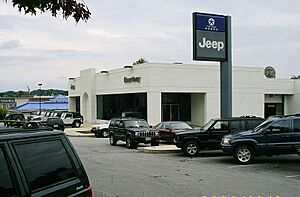
Jeep dealership in Rockville, Maryland (2004)
|
|
| Owner | Stellantis |
|---|---|
| Introduced |
|
| Related brands | Willys MB |
| Markets | Worldwide |
| Previous owners |
|
| Ambassador(s) | Bob Broderdorf, Jeep Brand CEO |
Jeep is a famous American car brand. It is known for making tough vehicles that can go almost anywhere. Today, Jeep is owned by a big company called Stellantis. Jeep has been part of Chrysler since 1987. That's when Chrysler bought the Jeep brand from its previous owner, American Motors Corporation (AMC).
Jeep mostly makes sport utility vehicles (SUVs). These include both crossovers and powerful off-road SUVs. They even make a pickup truck. In the past, Jeep also made other kinds of trucks, small vans, and even some roadsters. Some Jeep vehicles, like the Grand Cherokee, are considered luxury SUVs. The 1963 Wagoneer was one of the first luxury SUVs ever made.
Jeep sold 1.4 million SUVs around the world in 2016. This was a big jump from 500,000 in 2008. Most of these sales were in North America. Jeep was the best-selling brand for Fiat-Chrysler in the U.S. during the first half of 2017. There are over 2,400 dealerships in the U.S. that sell Jeep vehicles.
Before 1940, "jeep" was a slang word used by the U.S. Army. It referred to new recruits or vehicles. But the World War II "jeep" that started being made in 1941 gave the name to this specific light military 4x4 vehicle. Many people think these were the first mass-produced four-wheel-drive vehicles, like today's SUVs.
The Jeep became the main light four-wheel-drive vehicle for the United States Armed Forces and their Allies during World War II. It was also used after the war. The word "jeep" became well-known all over the world because of the war. Doug Stewart said the Jeep showed "Yankee ingenuity and cocky, can-do determination." It led to later military vehicles like the Humvee. It also inspired civilian cars like the first Series I Land Rover. Many similar vehicles have been designed in other countries since then.
The Jeep brand has been based in Toledo, Ohio, for a long time. This is where Willys–Overland started making the first CJ or Civilian Jeep models in 1945. The Jeep Wrangler series, which replaced the CJ, has been made since 1986. The Wrangler, with its strong axles and open top, is a very important part of the Jeep brand's identity.
Some Jeep models, like the CJ-5 and the SJ Wagoneer, were made for an amazing three decades without major changes. The word "jeep" (with a small "j") is still used as a general term for vehicles that can handle rough terrain. In Iceland, the word "Jeppi" (from Jeep) has been used for any type of SUV since World War II.
Contents
- Jeep's Role in World War II
- Jeep After the War
- What Does "Jeep" Mean?
- Jeep Brand and Trademarks
- Jeep Company History
- Military Jeep Models
- Civilian Jeep Models
- Jeep CJ (Civilian Jeep)
- Willys Jeep Station Wagon and Truck
- Willys / Jeep Jeepster & Commando
- Jeep Forward Control
- Jeep DJ (Dispatcher Jeep) and Fleetvan
- SJ Wagoneer, Cherokee and Pickups
- Jeep Cherokee (XJ) and Comanche
- Jeep Wrangler
- Grand Cherokee
- Jeep Liberty / Cherokee
- Jeep Commander
- Jeep Compass and Patriot
- Current Jeep Models
- Jeeps Made Outside the U.S.
- Jeep Apparel and Sponsorships
- See also
Jeep's Role in World War II
How the Jeep Was Developed
When it became clear that the United States would join World War II in Europe, the Army asked 135 companies to create new four-wheel-drive cars. These cars were needed for scouting missions. Only two companies replied: the American Bantam Car Company and Willys-Overland.
The Army gave them a very short deadline: 49 days to deliver a working car. Willys asked for more time but was told no. American Bantam had a small team, so their chief engineer hired Karl Probst, a talented designer. Probst started working on July 17, 1940, and drew up the full plans for Bantam's prototype, called the BRC (Bantam Reconnaissance Car), in just two days.
The Bantam prototype was built quickly using many parts already available from other cars. It was driven to Camp Holabird, Maryland, for Army testing on September 23. The car met almost all the Army's requirements.
Willys and Ford Join In
The Army worried that Bantam couldn't make enough vehicles fast enough. So, they gave Bantam's design to Willys and Ford. They encouraged these bigger companies to improve the design. The cars made by Ford (called the "Pygmy") and Willys (called the "Quad") looked very much like Bantam's car.
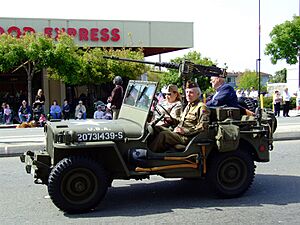
The Army built 1,500 of each model (Bantam BRC-40, Ford GP, and Willys MA). They tested them thoroughly in the field. The Army then changed the weight limit for the vehicle. This allowed Willys-Overland's chief engineer, Delmar "Barney" Roos, to use Willys's strong "Go Devil" engine. Willys won the first contract to produce the Jeeps.
The Willys version became the standard Jeep design, known as the model MB. It was built at their factory in Toledo, Ohio. The famous pressed-metal Jeep grille, with its vertical slots, was actually a Ford design feature. The Army liked it and included it in the final design.
Because the U.S. War Department needed many vehicles quickly, Willys-Overland allowed the U.S. Government to let another company make Jeeps using Willys's plans. The Army chose Ford as a second maker. Ford built Jeeps based on Willys's design. American Bantam, who created the first Jeep, made about 2,700 of their BRC-40 design. For the rest of the war, they built heavy-duty trailers for the Army.
Full Production: Willys MB and Ford GPW
The final Jeeps made by Willys-Overland were called the Model MB. Those made by Ford were called the Model GPW. There were small differences between them. Ford's versions had an "F" marked on almost every part. Early on, Ford also stamped their name on the back of their Jeeps. Willys did the same, but the U.S. government stopped both companies from doing this in 1942.
Even though many companies helped make parts for the Jeeps during the war, no "Jeep"-branded vehicles were sold until the 1945 Willys CJ-2A. Willys-Overland and Ford together made about 640,000 Jeeps for the war effort. This was about 18% of all wheeled military vehicles built in the U.S. during the war.
Jeeps were used by every part of the U.S. military. They were used for many jobs, like laying cables, as ambulances, and even as small tractors. An amphibious Jeep, called the GPA or "seep" (Sea Jeep), was made by Ford. However, it wasn't very successful as it was not great off-road or as a boat. About 30% of all Jeeps made during the war were sent to Great Britain and the Soviet Red Army.
Jeep After the War
After World War II, the Jeep was copied by many countries. These included France (by Delahaye and Hotchkiss et Cie), and Japan (by Mitsubishi Motors and Toyota). The Land Rover was also inspired by the Jeep. The simple, useful look of the original Jeep is still admired today. The Museum of Modern Art has even shown the Jeep as a great example of functional design.
Pulitzer Prize-winning war reporter Ernie Pyle called the Jeep one of the "two most important pieces of noncombat equipment ever developed." Jeeps became even more famous after the war when they were sold as military surplus.
The Jeepney is a special type of taxi or bus in the Philippines. The first Jeepneys were made from military-surplus Jeeps left behind after World War II. They were made longer and wider to carry more passengers. Over time, Jeepneys became a symbol of the Philippines. Today, most Jeepneys are built from scratch by local makers.
In the United States military, the Jeep was later replaced by other vehicles, like the M151, and more recently, the Humvee.
Underwater Jeeps
After World War II, Jeep tried out new designs. One idea was a model that could drive underwater! In 1950, a contract was approved for 1,000 units. These were "especially adapted for general reconnaissance or command communications" and built for "short period underwater operation." The engine was changed with a snorkel system so it could breathe underwater.
M715 Military Truck
In 1965, Jeep created the M715 1.25-ton army truck. This was a military version of the civilian J-series Jeep truck. It was used a lot in the Vietnam War. It had stronger axles and a flat windshield that could fold down. Today, other countries still use it, and Kia still makes it under license.
What Does "Jeep" Mean?
People have many ideas about where the word "jeep" came from. One popular idea is that it came from the military name GP. This stood for Government Purposes or General Purpose. People supposedly slurred "GP" into "Jeep." However, there's no clear proof that "GP" was used for the vehicle before the name "Jeep" became popular. The Ford GPW abbreviation actually meant G for government use, P for its 80-inch wheelbase, and W for its Willys-Overland designed engine.
Another idea, supported by R. Lee Ermey on his TV show Mail Call, says that soldiers were so impressed with the new vehicles that they named them after Eugene the Jeep. This was a character in the Thimble Theatre comic strip and cartoons from 1936. Eugene the Jeep was Popeye's "jungle pet." He was "small, able to move between dimensions and could solve seemingly impossible problems."
The word "jeep" was used even before World War I. It was U.S. Army slang for new recruits or for new, untested vehicles. In 1937, tractors supplied to the U.S. Army were called jeeps. Even an early version of the Boeing B-17 Flying Fortress airplane was called a jeep.
A dictionary of military slang from 1942, Words of the Fighting Forces, defined "Jeep" as:
Jeep: A four-wheel drive vehicle of one-half- to one-and-one-half-ton capacity for reconnaissance or other army duty. A term applied to the bantam-cars, and occasionally to other motor vehicles (U.S.A.) in the Air Corps, the Link Trainer; in the armored forces, the 1/2-ton command vehicle. Also referred to as "any small plane, helicopter, or gadget."
This definition is supported by the term "jeep carrier" for the Navy's small escort carriers.
In early 1941, Willys-Overland showed off the vehicle's off-road ability. They drove it up the steps of the United States Capitol. Willys test driver Irving "Red" Hausmann was driving. He had heard soldiers calling it a "jeep." When asked what it was called, Hausmann replied, "It's a jeep."
A newspaper article by Katharine Hillyer was published on February 19, 1941. It included a picture of the vehicle with the caption:
LAWMAKERS TAKE A RIDE – With Senator Meade, of New York, at the wheel, and Representative Thomas, of New Jersey, sitting beside him, one of the Army's new scout cars, known as "jeeps" or "quads", climbs up the Capitol steps in a demonstration yesterday. Soldiers in the rear seat for gunners were unperturbed.
This public display made the name "Jeep" stick to the 4x4 vehicle.
Jeep Brand and Trademarks
The "Jeep" brand has had many owners. Willys-Overland first applied for the "Jeep" trademark in February 1943. They ran ads to show how much they helped create the Jeep that won the war. Other companies, like Bantam, fought against Willys's claim for years. The Federal Trade Commission (FTC) even told Willys-Overland to stop claiming they "created or designed" the Jeep. Willys was only allowed to say they helped develop it.
However, Willys started making the first Civilian Jeep (CJ) branded vehicles in 1945. Since they were the only company that kept making "Jeep" vehicles after the war, Willys-Overland was finally given the registered trademark for the name "Jeep" in June 1950. Interestingly, King Features Syndicate also held a trademark on the name "Jeep" for their comics since August 1936.
FCA US LLC, the company that now owns the Jeep brand, holds the trademark for the name "Jeep" and its special 7-slot front grille design. The original 9-slot grille on World War II Jeeps was designed by Ford. It was lighter than Willys's original "Slat Grille," so it was used in the final standardized Jeep design.
The history of the HMMWV (Humvee) is also connected to Jeep. In 1971, Jeep's military vehicle division became AM General. This was a company owned by American Motors Corporation, which also owned Jeep. In 1979, AM General started designing the Humvee.
Amazing Off-Road Abilities
Jeep ads always highlight how well their vehicles can go off-road. Today, the Wrangler is one of the few four-wheel-drive vehicles that still has solid front and rear axles. These axles are known for being very strong and durable. New Wranglers come with a Dana 44 rear differential and a Dana 30 front differential. The special Rubicon model of the JK Wrangler has even more features for off-roading.
One great thing about solid axle vehicles is that they are easier and cheaper to "lift" with special suspension systems. Lifting a Jeep increases the space between the axles and the body. This allows bigger tires to be installed, which helps the Jeep go over even larger and tougher obstacles. Many owners also want to increase how much their suspension can move, or "flex." This helps all four wheels stay on the ground and keep traction when off-roading.
Smaller Jeeps are good off-road because they have short wheelbases and narrow frames. They also have good angles for approaching, going over, and leaving obstacles. This helps them get through places where bigger four-wheel-drive vehicles might struggle.
However, Jeeps do have some downsides. Their short wheelbase and lighter weight can make climbing very steep hills harder. Also, the solid axles are the lowest point of the vehicle, which can limit ground clearance. Older Jeeps also lacked basic safety features like doors, seatbelts, or roll cages, making them dangerous if they rolled over.
Jeep Company History
After the war, Willys stopped making passenger cars. They focused on Jeeps and Jeep-branded vehicles. They launched the Jeep Station Wagon in 1946, the Jeep Truck in 1947, and the Jeepster in 1948. Willys tried to make passenger cars again in 1952 with the Willys Aero sedan, but it didn't do well.
In 1953, Kaiser Motors bought Willys for $60 million. Kaiser first called the new company "Willys Motors," but changed it to Kaiser-Jeep in 1963. By the end of 1955, Kaiser-Frazer stopped making all passenger cars to focus only on Jeeps.
American Motors Corporation (AMC) then bought Kaiser's Jeep operations in 1970 for $70 million. Jeep's tough vehicles fit well with AMC's passenger car business. In 1971, AMC created a separate company called AM General for Jeep's commercial, postal, and military vehicles. AM General later developed the M998 Humvee. In 1976, Jeep introduced the CJ-7 and sold over 100,000 civilian units globally for the first time.
The French carmaker Renault started investing in AMC in 1979. Renault began selling Jeeps through their dealerships in Europe. During this time, Jeep introduced the XJ Cherokee, its first SUV with a single body frame. Global sales of Jeeps reached over 200,000 in 1985. However, by 1987, Renault was having financial problems. They decided to sell AMC.
Chrysler Corporation bought AMC in 1987. The main reason for the purchase was Jeep. After more than 40 years, the Jeep brand, which had been a successful part of smaller car companies, became part of one of the Big Three U.S. carmakers. Jeep was the only AMC brand that Chrysler kept.
Chrysler later merged with Daimler-Benz in 1998, forming DaimlerChrysler. During this time, Chrysler and Jeep sales were combined. DaimlerChrysler eventually sold most of its share in Chrysler in 2007. Chrysler and the Jeep division then operated under Chrysler Group LLC. In 2014, Chrysler became part of Fiat Chrysler Automobiles. Since 2021, Jeep has been part of Stellantis.
Jeeps have been built under license by different companies around the world. These include Mahindra in India, and Mitsubishi in Japan. Mitsubishi built over 30 models in Japan between 1953 and 1998. Most were based on the CJ-3B model.
Toledo, Ohio, has always been the home of the Jeep brand. The city is very proud of this history. Even though Jeeps are no longer made in the exact same factory as the World War II originals, two streets near the old plant are named Willys Parkway and Jeep Parkway. The Jeep Wrangler is still built in Toledo today.
American Motors started the first car-making partnership in China in 1984. This was Beijing Jeep Corporation, Ltd., which made the Jeep Cherokee (XJ) in Beijing. Production continued after Chrysler bought AMC. In October 2022, the partnership between Stellantis and a Chinese company ended. However, Stellantis plans to keep helping Jeep customers in China.
Military Jeep Models
This is a list of military vehicles made under the Jeep brand or by companies that later became part of Jeep.
- 1940 Willys Quad – Willys' first prototype for the U.S. Army.
- 1941 Willys MA – Willys' pre-production model before the main World War II Jeep.
- 1942–1945 Willys MB – The main World War II Jeep.
- 1949–1952 Willys MC / M38
- 1950 CJ V-35(/U) – A CJ-3A designed for deep water crossings.
- 1952–1971 Willys / Kaiser MD / M38A1
- 1967–1969 Kaiser Jeep M715 truck – Based on the civilian Jeep Gladiator.
Civilian Jeep Models
Jeep CJ (Civilian Jeep)
The CJ series were the first "Jeep" branded vehicles sold to the public. They started in 1945 with the CJ-2A. These early Jeeps are often called "flat-fenders" because their front fenders were flat, just like the original World War II model.
- 1945–1949 CJ-2A
- 1949–1953 CJ-3A
- 1953–1968 CJ-3B
- 1954–1983 CJ-5
- 1976–1986 CJ-7
- 1981–1985 CJ-8 Scrambler
Willys Jeep Station Wagon and Truck
- The 1946–1965 Willys Jeep Station Wagon and the
- 1947–1965 Willys Jeep Truck shared many design features.
The wagon was very successful for Willys after World War II.
Willys / Jeep Jeepster & Commando
The Jeepster, introduced in 1948, was based on the Jeep Station Wagon.
- 1948–1951 Willys VJ Jeepster
- 1966–1971 C101—Jeepster Commando
- 1972–1973 C104—Jeep Commando
Jeep Forward Control
- The 1956–1965 Jeep Forward Control was made in both civilian and military versions.
Jeep DJ (Dispatcher Jeep) and Fleetvan

From 1955, Willys offered two-wheel-drive versions of their CJ Jeeps for commercial use. These were called DJ models. A well-known version was the right-hand drive model with sliding side-doors, used by the U.S. Postal service for mail delivery.
- 1955–1964 DJ-3A
- 1965–1975 DJ-5
Fleetvan Jeep
- 1961–1975 Fleetvan
SJ Wagoneer, Cherokee and Pickups
SUV models (1962–1991)
- 1962–1983 SJ Wagoneer
- 1974–1983 SJ Cherokee
- 1984–1991 SJ Grand Wagoneer
Pickup models (1962–1988)
- 1962–1971 Jeep Gladiator (SJ)
- 1971–1988 Jeep pickup truck (J-)
Jeep Cherokee (XJ) and Comanche
- 1984–2001 XJ Cherokee
- 1986–1992 Jeep Comanche (MJ)
Jeep Wrangler
- 1987–1995 Jeep Wrangler YJ
- 1997–2006 Wrangler TJ
- 2007–2018 Wrangler JK
- 2017 – Jeep Wrangler JL
- 2019 – Jeep Gladiator JT (a pickup truck version)
Grand Cherokee
- 1993–1998 Grand Cherokee ZJ
- 1999–2004 Grand Cherokee WJ
- 2005–2010 Grand Cherokee WK
- 2011–2022 Jeep Grand Cherokee WK2
- 2021–Present Jeep Grand Cherokee WL
Jeep Liberty / Cherokee
- 2002–2007 Jeep Liberty KJ (or Jeep Cherokee outside North America)
- 2008–2012 Jeep Liberty KK (or Jeep Cherokee outside North America)
Jeep Commander
- 2006–2010 Jeep Commander (XK)
Jeep Compass and Patriot
- 2007–2017 Jeep Compass MK49
- 2017–present Jeep Compass MP/552
- 2006–2017 Jeep Patriot (MK74)
Current Jeep Models
- Jeep Renegade: A smaller SUV.
- Jeep Wrangler: A classic off-road SUV, available in 2-door and 4-door versions.
- J8: A military version of the Wrangler.
- Jeep Gladiator (JT): A mid-size pickup truck, released in 2019.
- Jeep Grand Cherokee: A mid-size SUV.
- Jeep Compass: A compact SUV.
- Jeep Commander: A mid-size SUV mainly for certain markets.
- Jeep Wagoneer/Jeep Grand Wagoneer (WS): Large, full-size SUVs.
- Jeep Avenger: A crossover electric vehicle (EV) SUV.
- Jeep Wagoneer S: A coupe-style electric vehicle (EV) SUV.
- Jeep Recon: A mid-size electric vehicle (EV) SUV inspired by the Wrangler.
Jeeps Made Outside the U.S.
Jeeps have been built or put together in many countries around the world.
- Argentina – IKA Jeeps (1956–present)
- Brazil – Willys Overland do Brasil, later Ford do Brasil (1957–1985). The Troller T4 is a fiberglass Jeep version made in Brazil.
- China – Beijing Jeep Corporation (1983 to 2009).
- India – Mahindra & Mahindra Limited (1960s–present).
- Japan – Mitsubishi Jeeps (1953–1998).
- Philippines – Jeepneys are unique buses made from old Jeeps.
- Spain – Vehículos Industriales y Agrícolas, S.A (VIASA) (1960–1990s).
Jeep Apparel and Sponsorships
Jeep is also a brand for outdoor clothing and gear. These products are sold under a license. There are many stores selling Jeep apparel, especially in China.
Jeep has also sponsored sports teams. In April 2012, Jeep signed a deal with the Italian football (soccer) club Juventus. In August 2014, Jeep sponsored the Greek football club AEK Athens F.C.. Since 2018, Jeep has been the main sponsor of France's top men's professional basketball league, which is now called Jeep Élite.
Sponsorships
 Dewa United
Dewa United Juventus
Juventus Al-Nasr
Al-Nasr Balestier Khalsa
Balestier Khalsa
See also
 In Spanish: Jeep para niños
In Spanish: Jeep para niños
- Willys MB – The original Jeep from World War II.
- Sport utility vehicle – What SUVs are.
- Military light utility vehicle – Other military vehicles like the Jeep.
- Land Rover – A British car brand similar to Jeep.
- Jeepney – Buses in the Philippines made from old Jeeps.


